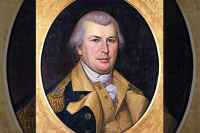Simple signs of the evergreen
You can almost smell the word “evergreen.” The word is at once one of the most aptly descriptive and highly evocative botanical terms. Simply reading or hearing it conjures up a mix of personal associations with particular landscapes.
Evergreens are with us year-round, of course, but from spring through fall they blend into a landscape comprised of a multitude of herbaceous or broad-leaved deciduous plants. Winter is the evergreen time of the year. It’s the season when the dominant colors of the landscape are the varied green hues of those trees, vines, shrubs, and ferns that do not lose their leaves or needles. For gardeners and outdoor enthusiasts alike, it’s the prime time for paying a closer attention to this particular category of plant life.
The ancient Cherokees were — by necessity and inclination — close observers of plant life. They wondered why some plants lose their leaves while others are evergreen. When anthropologist James Mooney was collecting Cherokee myths and lore during the late 1880s for his monumental Myths of the Cherokees (Bureau of American Ethnology, 1900), the medicine man Swimmer, who lived in the traditional Big Cove community, explained how it had been determined this came about:
“When the animals and plants were first made — we do not know by whom — they were told to watch and keep awake for seven nights. They tried to do this, and nearly all were awake through the first night, but the next night several dropped off to sleep, and the third night others were asleep, and then others, until, on the seventh night, of all the animals only the owl, the panther, and one or two more were awake. To these were given the power to see and to go about in the dark, and to make prey of the birds and animals which must sleep at night. Of the trees only the cedar, the pine, the spruce, the holly, and the laurel were awake to the end, and to them it was given to be always green and to be the greatest medicine, but to the others it was said: Because you have not endured to the end you shall lose your hair every winter.’”
Everyone knows the basic definition of an evergreen as a plant that “holds green leaves, either broadleaf or needle-shaped, over winter.” But an understanding — however rudimentary — of why some plants “choose” to remain evergreen and how they go about doing so will enable us to appreciate them more fully.
All plants in upland or northern environments face the double-edged dilemma of a lack of moisture in winter and a short growing season in summer. Most opt to hunker down in cold weather and then really hustleduring the growing season to do their thing and produce seed.
Related Items
Evergreens have taken the other path. Instead of shedding leaves or dying completely back in above-ground forms, evergreens have “opted” to tough it out and get a head start on the growing season. For this group of plants, photosynthesis can continue longer in the fall and begin earlier in spring; and, for them, energy that would otherwise be channeled into leaf reproduction is saved for direct reproductive efforts.
Various strategies allow evergreens to weather the drying winds and freezing temperatures of winter. The needle-like leaves of conifers expose less surface to cold drying winds. Their waxy needles, stems, and roots are filled with botanical “antifreeze” in the form of resinous chemicals. Conical shapes minimize buildups of snow or ice.
Other woodland evergreen plants have developed woody stems and thick leaves with waxy coats to cut down on evaporation. These tend to be shrubby or even ground hugging. In order to avoid having leaf cells ruptured by frost, water is channeled to spaces between the cells where expansion does less damage. And finally, the sugar content of the cells is increased to lower freezing points.
Individual evergreen species often have distinctive over-wintering devices. Everyone has observed how rhododendron leaves curl and droop in extreme cold. This posture obviously lessens exposure to wind, while the curling temporarily closes off the air-circulation pores (stomata) on the underside of the leaves. This dormant posture is also assumed during periods of drought.
Here in the Great Smokies region, a considerable body of lore has grown up around the fine art of predicting the weather. The drooping and curling of rhododendron leaves has not gone unnoticed. John Parris, a long-time columnist for the Asheville Citizen-Times now deceased, devoted an entire column titled “Tell Weather by Rhododendron’s Curl” to this topic:
“The thick, leathery leaves of the rhododendron bushes were curled tighter than a homemade twist of tobacco. As mountain weather sharps well know, it’s a sign of winter for a fact when rhododendron leaves, though evergreen, droop and roll inwards ... they make weather prognosticating as easy as falling off a log and a heap sight less certain. To the weather sharps, a rhododendron leaf reacts the same way as mercury in a store-bought thermometer. When the temperature drops, they begin to droop and curl. As the mercury falls lower, the edges begin to curl under. The colder it gets the tighter the curl becomes. When it gets down nearly to zero, the entire leaf is rolled tight and at zero it looks like a green pencil hanging on a bush. From then on as sub-zero sets in, the leaf takes on a sort of hard brittleness and a blue-greenness. To those who have devoted years of constant study to the leaf thermometers, there is a familiarity of the tightening curl that is as easy to read in terms of degrees as the markings on a store-bought thermometer. Chances are a real reader of the rhododendron thermometer won’t be off more than a degree from the mercury register of a store-bought thermometer. Of course, a body doesn’t come by such a knack overnight. Most anybody can read the simple signs. But when it comes to the fine reading, then that calls for more years than a few at studying rhododendron leaves and measuring their curl down to a hair’s-breadth with the eye. Folks who fall into this category are rare and far between these days. They are old-timers, born and raised in the mountains, folks with a pleasure for the old things which they figure still have their use.”
Aside from the conspicuous conifers and other obvious evergreen plants such as American holly, rhododendron, laurel, doghobble, and sand myrtle, there are a number of small woodland evergreens. Trailing arbutus, galax, teaberry, and the dainty little partridge-berry vine are always a delight to encounter nestled among the brown leaf-litter while out on a winter walk. They lift my spirits on a gloomy, slushy day.
My favorite evergreen sub-shrub is galax, which displays spikes composed of tiny white flowers in mid-summer. When the first heavy frosts arrive here in the mountains, the rounded dark green leaves display eye-catching bronze, wine, and crimson colors. Galax was once in peril due to over-collection by mountain families who gathered the plant for sale as a Christmas ornamental. The town of Galax in the Blue Ridge of Virginia is so-named because it was situated in an area where the plant was systematically harvested. Today galax is used mostly in the floral trade. You would be hard pressed to go into a florist’s shop where a wreath is being constructed and not observe galax being incorporated therein.
The most prominent evergreens, of course, are the various conifers. What would the winter landscapes across North America be without the varied and often intermixed green hues of pine, spruce, fir, hemlock, cedar, and cypress? When out bird watching during the winter months, my wife and I always search the conifers. Here in the Smokies region a variety of winter residents — chickadees, kinglets, nuthatches, brown creepers, titmice, crossbills, and others — are attracted to conifers for shelter, protection from predators, and food. The cones provide seeds and the scaly, plate-like bark harbors a variety of insects.
An excellent general guide to evergreen plants — including the hardy ferns and clubmosses — is Donald Stokes’ A Guide to Nature in Winter (Little, Brown & Co., 1976). This volume covers a variety of other topics like winter weeds, insects, birds and their nests, mushrooms, and tracks that will stimulate you to get out the door and poke around during the evergreen time of the year.
George Ellison wrote the biographical introductions for the reissues of two Appalachian classics: Horace Kephart’s Our Southern Highlanders and James Mooney’s History, Myths, and Sacred Formulas of the Cherokees. In June 2005, a selection of his Back Then columns was published by The History Press in Charleston as Mountain Passages: Natural and Cultural History of Western North Carolina and the Great Smoky Mountains. Readers can contact him at P.O. Box 1262, Bryson City, N.C., 28713, or at This email address is being protected from spambots. You need JavaScript enabled to view it..









